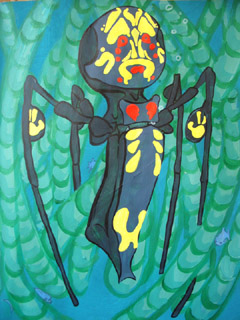
Bright markings on a creature are often nature's way of saying "danger!" Nowhere is this more true than with Indonesia's Heartbreak Spider.
This four-foot-tall aquatic spider is adorned with brilliant yellow and red markings, which bear an uncanny resemblance to a scared human child:
- The spider's proportionally-small and raised abdomen simulates the child's head. Many see weeping eyes and a face in the pattern of the abdomen's markings.
- The cephalothorax lacks pedipalps; instead, there is an exceptionally long and toothy jaw. Markings on the jaw are often interpreted as a human ribcage and pelvis.
- Also unlike most spiders, this specimen has only four legs -- each of which sports a flexible air bladder, with markings on the front two that look quite like hands.
- Adorning the creature's "nose" are two more red markings, which look just like a broken heart.
Heartbreak Spiders consume fish and waterfowl -- but they are particularly suited to snaring human prey. Around twilight, when visibility is poor, the creature comes up from its underwater nest, and lurks half-submerged in the shallows of a slow-moving river...
When a human passes by, the spider goes into spasms, splashing about -- which in the half-dark causes it to look very much like a drowning child. When the passerby attempts rescue, it grabs onto their leg with its powerful jaw and pulls them down to a watery death. The spider is able to stay there underwater for up to two weeks at a time.
Tangentially, it should be mentioned that there is another species involved with the Heartbreak Spider, which enjoys a symbiotic relationship: the Bone Fish. Bone Fish, as one might guess, eat bones. They take no interest in meat from the spider's prey -- but after the bare skeleton has been discarded, they use their sharp little teeth to break it down into digestible chips. No evidence of the victim is left to be found. This deadly partnership has contributed to the spider having remained anonymous for so long.
In the past, a few remote communities have become aware that something is living in the rivers, dragging people to their deaths. An additional "heartbreak" caused by the spider is that in several cases children have simply been allowed to drown, because adults suspected that the child was really a magical "monster" trying to lure them into the water.
The catastrophic tsunami of December 26th 2004 not only devastated the human population -- it also wiped out more than 80% of this spider species. However, three years after the wave, the species is beginning to reemerge -- and in places where it had not been seen before. It appears that the flood waters swept the spiders' eggs up into areas where they have not existed previously... Bringing them into contact with entirely new potential victims.


No comments:
Post a Comment